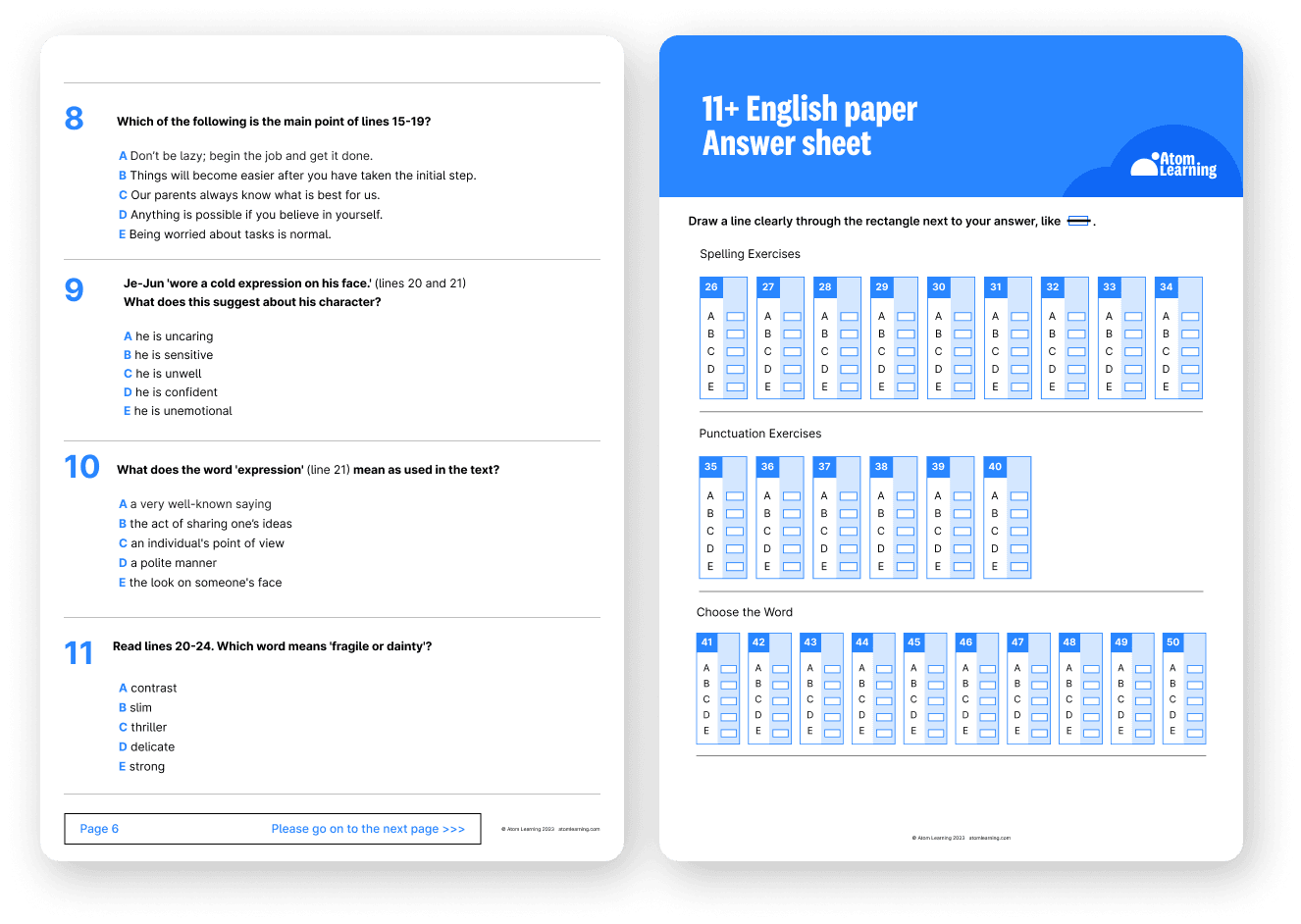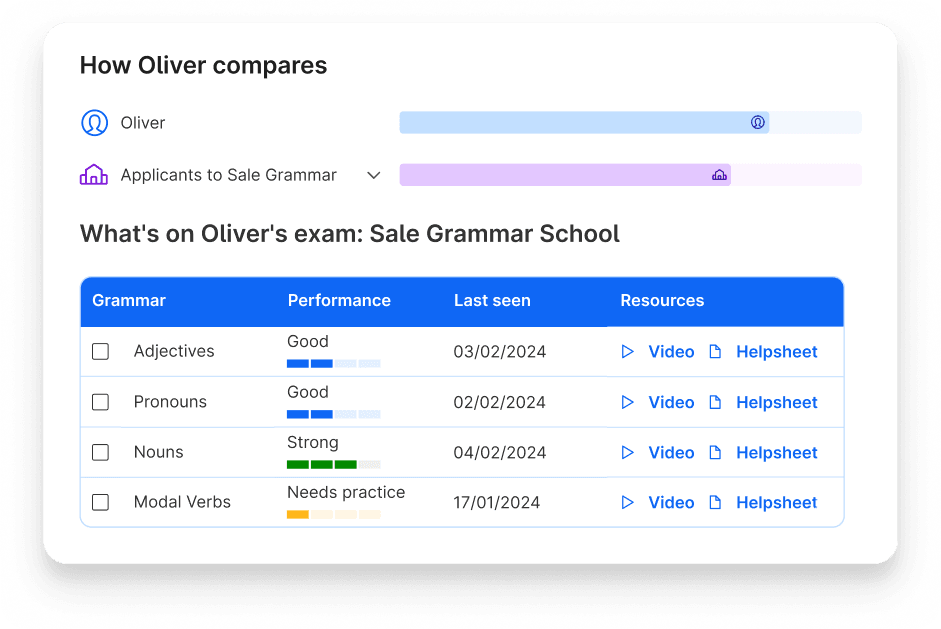Reading comprehension plays an important role in most 11+ and independent school entrance exams, and is a key focus on the English paper.
So, what exactly is tested and how can you help your child prepare with confidence?
In this guide, we’ll explain:
What does reading comprehension mean in the context of the 11+?
What types of questions might your child see?
How do different exams approach comprehension?
Practical ways to build your child’s skills at home
What is reading comprehension?
Reading comprehension means being able to read a text and understand it. It’s not just about reading the words - it’s about understanding what they mean, connecting ideas, and thinking about what’s being said.
In exams, children are tested on how well they can find information, read between the lines, and understand the meaning of a text.
Types of reading comprehension questions
Not all comprehension questions are the same. Helping your child get familiar with the different types can make a big difference in how they approach their exams.
1. Vocabulary questions
These questions test a child’s understanding of specific words in the text. They might be asked to define a word or choose a synonym (a word with the same meaning) from multiple options.
How to prepare: Encourage your child to read widely and explore our free 11+ vocabulary lists. Each word comes with a clear definition and an example sentence to help build your child’s vocabulary.
2. Retrieval questions
These questions ask your child to find specific details in the text. They'll need to be able to find the answers in the passages provided.
How to prepare: Teach your child to scan texts to find key information quickly. Try practising with short extracts and simple tasks to build confidence and accuracy.
3. Inference questions
Inference questions require children to read between the lines. Instead of directly stated answers, they have to use clues from the text to understand what’s implied.
How to prepare: Discuss books and passages with your child. Ask open-ended questions like, “Why do you think the character felt that way?” to encourage deeper thinking.
4. Summary questions
These questions assess how well your child can pick out the main ideas and sum up information clearly from a passage.
How to prepare: Ask your child to practise summarising short paragraphs in their own words, focusing on the key points and leaving out extra details.
5. Author’s intent and literary techniques
Some questions focus on why the author wrote the text the way they did. Your child might be asked about tone or purpose, as well as about techniques such as metaphors and similes.
How to prepare: Read a variety of texts together. As you read, point out features like descriptive language, persuasive phrases, or storytelling techniques. Talk about why the author might have used them.
Try our free 11+ course
Help your child prepare for 11+ entrance exams with Atom's free 11+ course.
Get four GL Assessment style practice papers (English, maths, verbal reasoning and non-verbal reasoning), marking guidance, and video lessons sent straight to your inbox!
What format are reading comprehension exams?
GL Assessment 11+ comprehension
Most grammar schools use GL Assessment for their 11+ entrance exams. The English paper format can vary between schools, but most papers include:
A reading comprehension task
Questions on spelling, punctuation, and grammar
The comprehension section includes a passage, which could be fiction, non-fiction, or poetry, and either a traditional or contemporary text.
Your child will be tested on how well they:
Understand the text
Read between the lines (infer and deduce information)
Understand vocabulary in context
The most common format is multiple-choice, but some schools may ask for short written answers instead.
The picture below shows the format of a downloadable GL Assessment 11+ English comprehension practice test, available with an Atom Home subscription. You’ll also find online practice tests included with your Atom subscription.

ISEB English
The ISEB Common Pre-Test includes an English test, with two sections:
Reading comprehension
SPaG (spelling, punctuation and grammar).
The questions are adaptive, so if your child answers questions correctly, they become more challenging.
Your child will read a series of short passages (about 300–500 words each). These can be fiction, non-fiction, or poetry, and may come from different time periods. The test is taken on a computer, and your child can scroll through the text as they read.
All the questions are multiple choice.
Take a look at the format of an ISEB English test, as shown on Atom.
Year 6 SATs reading
The Year 6 SATs reading paper has a time limit of 60 minutes (including time for reading). It’s worth 50 marks and follows the Key Stage 2 national curriculum.
Your child will read three texts, each followed by a set of questions. These texts can be different genres, such as fiction, non-fiction, or poetry.
Some questions include a page reference, showing your child exactly where to look for the answer. They should read one text, answer the questions, then move on to the next text.
The space provided for each answer gives a clue about how detailed the response should be.
Year 6 SATs practice tests are available on Atom. The reading tests look like this:
Cambridge Select Insight comprehension
Comprehension is one of the longest sections on the Cambridge Select Insight test (previously known as CEM Select). It is included in the verbal reasoning section, as there is no separate English paper.
Like ISEB, it’s taken on a computer. Your child will see a scrollable passage of fiction or non-fiction on the left side of the screen, with questions appearing on the right.
Here's an example comprehension question in a Cambridge Select Insight test on Atom.
FSCE 11+ English
A few grammar schools in England use 11+ exams set by FSCE.
In the English paper, your child will read a short passage, either fiction or non-fiction, and answer questions that test how well they’ve understood it.
The example below shows a question from a Reading School 11+ practice test on Atom. Reading School uses FSCE for its entrance exam.
How to develop your child's comprehension skills
There are lots of ways you can help develop your child's comprehension skills at home. Here are a few tips to get you started.
Read widely
The best way to strengthen comprehension is to read often and to read a variety of texts. Fiction, non-fiction, poetry, newspapers - it all helps.
You can also encourage your child by modelling reading habits. Showing your child that reading is an activity you do for entertainment or relaxation can influence them.
Try reinforcing this with positive comments, such as "I'm going to relax with my book now", or "My book is so good, I can't put it down!"
Need some inspiration for books to read?
Discover our top picks for kids aged 7–11.
We’ve got over 60+ book recommendations for each age group, spanning classics, modern fiction, picture books and non-fiction.
Ask questions while reading together
If you’re reading with your child, try asking questions to help them think more deeply about the text.
For example:
What do you think will happen next?
How would you describe this character?
How might the story change from another character’s point of view?
Can you summarise what’s just happened?
Develop exam technique
Good exam technique can help your child stay calm and tackle tricky questions with confidence. Here's our strategy for approaching comprehension questions:
Read the passage more than once.
Read the question carefully. Look out for keywords like “in your own words”. If your child is doing a paper test, they can underline command words (e.g. who, what, why, how). If the question mentions a specific part of the text (e.g. lines 36–38), make sure they reread that section.
Check how many marks are available for the question. The number of marks gives a clue to how detailed the answer should be. Aim to make one clear point for each mark, and always write in full sentences. For multiple-choice questions, encourage your child to rule out the incorrect answers first before choosing the best one.
Take a deep breath before moving on to the next section. Remind your child to focus on their own test and not compare themselves to others in the exam room.
Make reading comprehension easy with Atom!
Preparing for the 11+? Atom Home gives your child a clear path to exam success - all in one package.
Here’s how Atom can help:
Know what to revise with weekly plans tailored to your target schools
Stay motivated with 90,000+ interactive questions and 500+ hours of video lessons
Cover every subject - English comprehension, SPaG, maths, verbal and non-verbal reasoning
Improve exam technique with realistic mock tests for the 11+, ISEB, Cambridge Select Insight, CAT4 and more
Track progress and see how your child is improving
Try Atom for free
Start your free trial today and we’ll create a tailored plan just for your child. Simple, stress-free exam prep, from day one.

